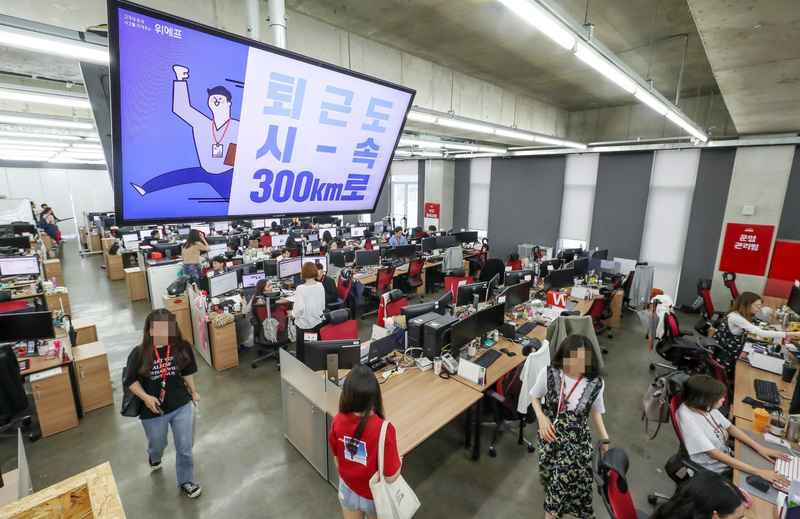Posted on : Oct.7,2018 14:12 KST
KT big data study finds that reduced working hours leads to improved quality of life
The effects of the 52-hour cap on the work week introduced on July 1 are becoming increasingly apparent. Most notably, the amount of time workers spend near their place of employment after working hours has dropped, while leisure-related sales have risen. The findings were confirmed in a KT analysis of population movement data using mobile phone base station access information and a BC Card analysis of sales at affiliated businesses.
According to data released by KT on Oct. 2, working people in the areas of Gwanghwamun and Yeouido in Seoul and Pangyo in Gyeonggi Province are spending less time in the vicinity of their workplaces. For its analysis, KT used signals exchanged between base stations and mobile phones to isolate population movement data, with “working people” for the regions defined as mobile phone users who remained in the area between 9 am and 6 pm for at least 10 days a month and had over four hours of total monthly base station access time.
While KT was unable to conclusively determine that the time spent within base station area as shown by the study’s data represented actual working hours, the numbers did show trends in individual schedules following the introduction of the 52-hour weekly limit on working hours.
 |
|
Employees of the e-commerce firm Wemakeprice leave the company’s headquarters in Seoul’s Gangnam District on July 2, the first Monday after the introduction of the 52-hour work week. (Yonhap News)
|
“The patterns of reduced stay times near working places were virtually identical for August and September, suggesting that the extended heatwave did not have a significant effect on reducing stay times,” said a KT official who took part in the analysis.
Between Aug. 1 and Sept. 16, working people in Seoul’s Gwanghwamun area averaged 516 minutes a day near their place of employment – down 55 minutes from the same period in 2017 before the introduction of the 52-hour limit. Stay times in the Pangyo area of Seongnam, Gyeonggi Province – home to numerous IT and gaming companies – were down 12 minutes from 531 to 519. In Yeouido, where many people are employed in finance, businesses were granted a grace period on the system’s adoption, yet stay times were down by seven minutes from 588 to 581. In contrast, stay times for working people in the Gasan Digital Complex Area – where many workplaces have fewer than 300 employees and are not yet subject to the 52-hour limit – rose by six minutes from 522 to 528.
 |
|
Employees of the e-commerce firm Wemakeprice leave the company’s headquarters in Seoul’s Gangnam District on July 2, the first Monday after the introduction of the 52-hour work week. (Yonhap News)
|
Changes in commute times and increased leisure-related sales
Differences from last year were also observed in commute times following the adoption of flexible working systems. In 2017, 26% of all working people in the Gwanghwamun area arrived there between 7:30 and 8 am; this year, the arrival numbers were down to 15%. In contrast, the proportion arriving between 8:30 and 9 am rose to 38% from 21% last year, suggesting an overall delay in morning commute times. The percentage of working people departing the Gwanghwamun, Yeouido, and Pangyo areas alike reached a maximum of 31.4% in the 6–7 pm period, up seven percentage points from last year.
Perhaps thanks to the reduced workplace area stay times, leisure activity-related sales were up from 2017. Sales for 5,574 leisure-related businesses (including cinemas, bookstores, driving ranges, bowling alleys, tennis courts, swimming pools, and fitness centers) among BC Card’s 424,838 affiliate members in central Seoul during the period from Aug. 19 to Sept. 15 were up by 9.2% from the same period (Aug. 20 to Sept. 16) last year.
In financial terms, the difference translated into about 1.6 billion won (US$1.4 million). Fitness center membership was up by 39%, while swimming pool transactions rose by 36.6%.
Sales increased by 42.7–70.3% from the same period in 2017 for the Dongjak, Gangseo, and Dongdaemun districts of Seoul, compared to decreases of 6.7–7.7% for the Geumcheon and Jongno districts of Seoul, which are home to numerous business areas. Food- and alcohol-related sales after 6 pm fell by 10.3–14.7% for the Gwanghwamun and Pangyo areas.
“Big data have shown changing lifestyle patterns with improved quality of life, including a decrease in average daily working hours for working people and conformity to a ‘nine to six’ pattern for commuting times,” said Yoon Hye-jeong, who heads KT’s big data project support team.
“We are planning to use our big data analysis capabilities to develop new services suited to consumer lifestyle patterns,” she added
By Park Tae-woo, staff reporter
Please direct comments or questions to [english@hani.co.kr]











